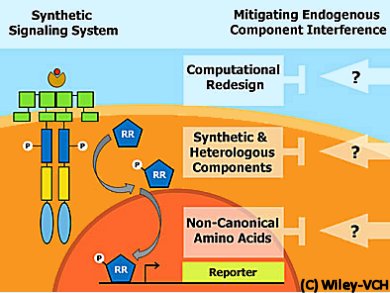Synthetic biology uses biological components to engineer new functionality in living organisms. Biological components are generally not as well characterized as their electronic counterparts. Therefore, systems produced with biological parts often exhibit unexpected or undesirable characteristics that are dependent on their interaction – also called crosstalk – with endogenous components from the organism where these systems are used.
One approach to dealing with this crosstalk would be to design a system that interacts so specifically that there is no possibility of crosstalk with endogenous components. Another approach is to use computational redesign of proteins and directed evolution to engineer “privileged” interfaces in the synthetic signaling system.
June Medford, Colorado State University, Fort Collins, CO, USA, and colleagues discuss current approaches in the field including the design of synthetic components, partially synthetic systems that utilize crosstalk to signal through endogenous components, computational redesign of proteins, and the use of heterologous components.
The reseachers have designed and produced the first eukaryotic synthetic signal transduction system using the principles of synthetic biology. Bacteria, yeast, and plants sense environmental aspects through conserved histidine kinase (HK) signal transduction systems. The reseachers build a synthetic signaling system using the functional conservation of HK pathways between bacteria and plants. Using synthetic signaling components these plants serve as environmental monitors, e.g., detecting explosives.
- Crosstalk between endogenous and synthetic components – synthetic signaling meets endogenous components,
Kevin J. Morey, Mauricio S. Antunes, Matt J. Barrow, Fernando A. Solorzano, Keira L. Havens, J. Jeff Smith, June Medford,
Biotechnol. J. 2012, 7, 846–855.
DOI: 10.1002/biot.201100487 - Engineering key components in a synthetic eukaryotic signal transduction pathway,
Mauricio S .Antunes, Kevin J. Morey, Neera Tewari-Singh, Tessa A. Bowen, J. Jeff Smith, Colleen T. Webb, Homme W. Hellinga, June I. Medford,
Molecul. Syst. Biol. 2009, 5 (270).
DOI: 10.1038/msb.2009.28
Also of interest:
- Special Issue: Synthetic Biology
Biotechnol. J. 2012, 7(7). - Interview with Frances H. Arnold — Design by Evolution,
ChemViews magazine 2012.
DOI: 10.1002/chemv.201000143
Caltech Professor Frances H. Arnold sees laboratory evolution designing biology as solution to human problems




